Aarties

What is Aarti ?
Aarti is generally performed one to five times daily, and usually at the end of a puja or bhajan session. It is performed during almost all Hindu ceremonies and occasions. It involves the circulating of an 'Aarti plate' or 'Aarti lamp' around a person or deity and is generally accompanied by the singing of songs in praise of that deva or person (many versions exist). In doing so, the plate or lamp is supposed to acquire the power of the deity. The priest circulates the plate or lamp to all those present. They cup their down-turned hands over the flame and then raise their palms to their forehead - the purificatory blessing, passed from the deva's image to the flame, has now been passed to the devotee.
The purpose of performing aarti is the waving of lighted wicks before the deities in a spirit of humility and gratitude, wherein faithful followers become immersed in God's divine form. It symbolises the five elements: 1)akash(ether), 2)vayu(wind), 3)agni(fire), 4)jal(water), and 5)pruthvi(earth). Communal Aarti is performed in the mandir; however, devotees also perform it in their homes.